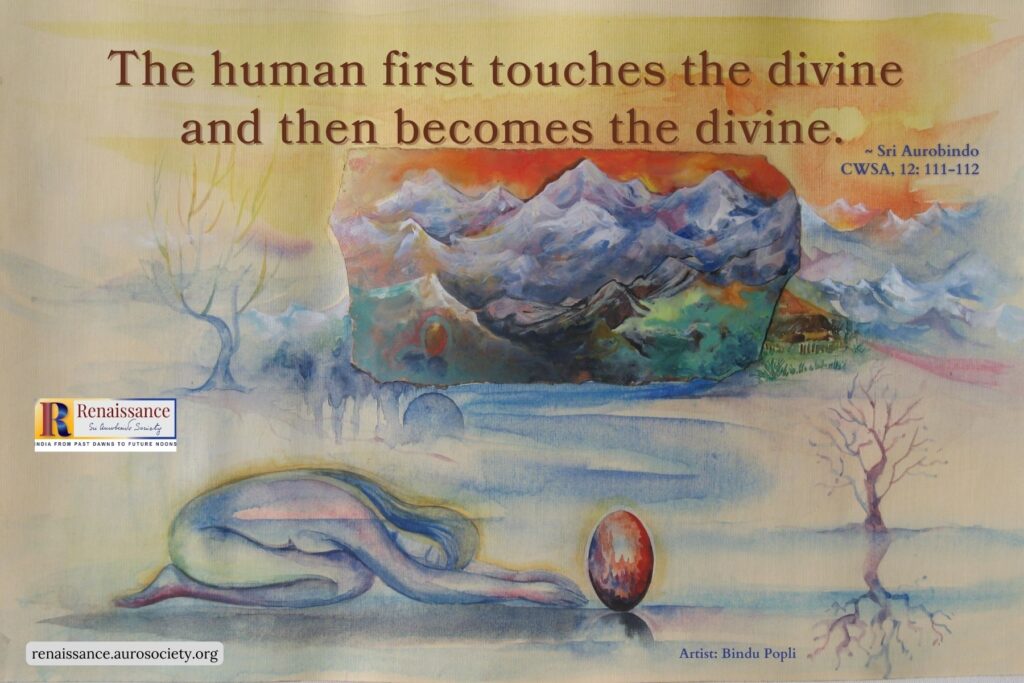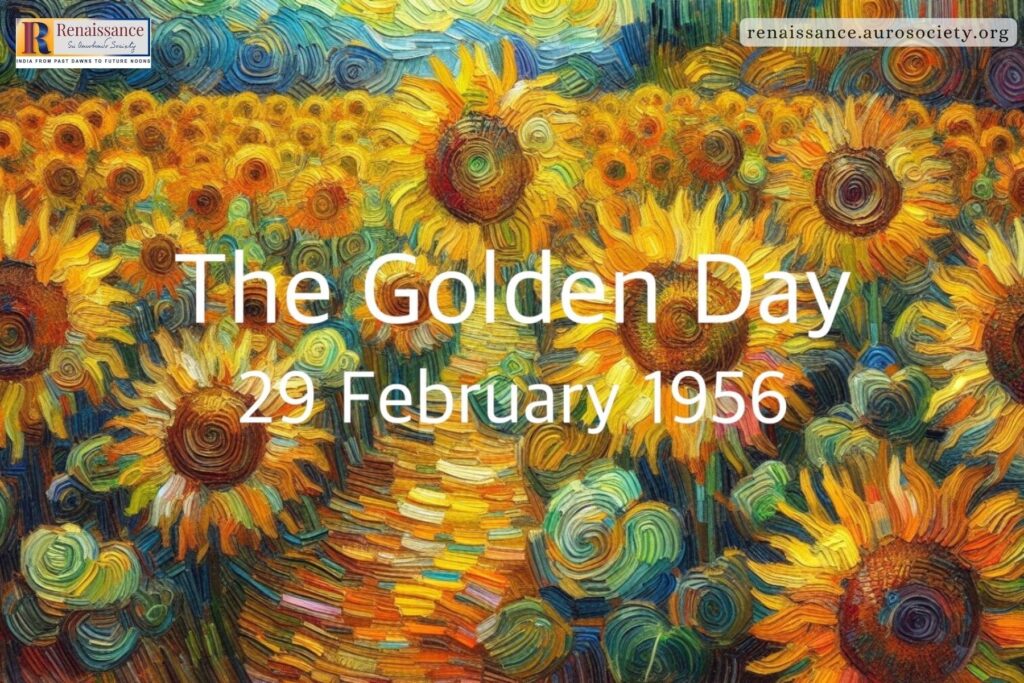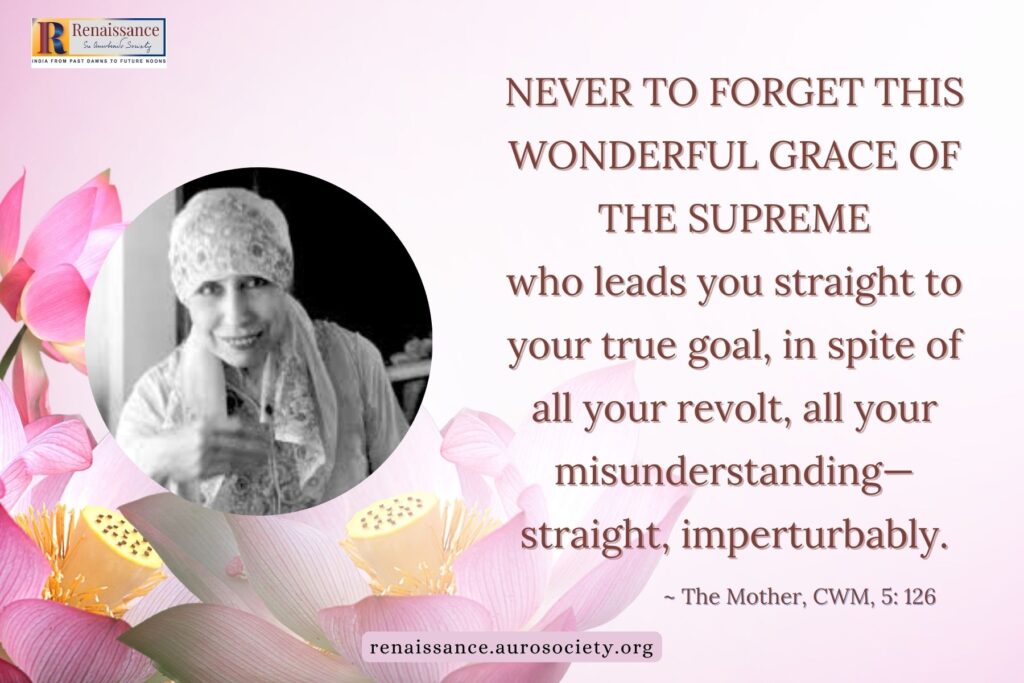Editor’s note:
“Sri Aurobindo was not compelled to leave his body, he chose to do so for reasons so sublime that they are beyond the reach of human mentality.”
~ The Mother, CWM, Vol. 13, p. 8
On December 5, 1950 at 1:20 AM, Sri Aurobindo left his physical body. Nirodbaran has written that by the morning of 5th December, the entire body was seen to be suffused with a golden-crimson hue, “so fresh and so magnificent, lifting us from the pall of gloom to a mute wonder.” This Supramental Light remained for five days at a stretch and many people witnessed the magnificent and unique phenomenon.
In the January 1951 issue of Mother India, Amal Kiran wrote a deeply insightful essay about the inner significance of passing of Sri Aurobindo, and its consequence for the next steps of Supramental Yoga. He clarified later that he had written this essay before he came to know what the Mother herself had said around the time of Sri Aurobindo’s passing:
When I asked Him (December 8, 1950) to resuscitate his body, He clearly answered: “I have left this body purposely. I will not take it back. I shall manifest again in the first supramental body built in the supramental way.”
~ CWM, Vol. 13, p. 9
Before publishing, the essay was sent to the Mother for her approval.
In a telegram sent by Nolini Kanta Gupta, the Mother conveyed her full approval and added “nothing to change” (27.12.1950). Her approval was also conveyed through Yogendra to Soli Albless, Associate Editor of ‘Mother India’: “I have read Amal’s article. It is excellent. Tell him I am extremely satisfied. I would like to have it printed in booklet form. He can get it printed in Bombay. If not, I’ll print it here.” (28.12.1950). And then again, a day later another message was sent: “It is quite the best thing Amal has written. I would like to print 15,000 copies.” (29.12.1950).
We bring this special essay for our readers, presented in 4 parts. Only a few minor formatting changes have been made for this digital presentation.

PART 1
. . . neither you nor anyone else knows anything at all of my life; it has not been on the surface for man to see.
~ Sri Aurobindo, CWSA, Vol. 36, p. 11
“No one can write about my life because it is not on the surface for men to see” — this is what Sri Aurobindo said when the idea of a definitive biography was mooted. There is no doubt that, except perhaps for his brilliant academic career in England and the early phases of his fiery political period in India, his life was too deeply inward for its utmost sense and motive and achievement to be unravelled by a narration of external events supplemented by a psychological commentary.
To arrive at some vision of it one would have to catch an inkling of not only the vast mysteries of traditional spiritual realisation but also the dazzling immensities of the new earth-transforming light which he called the Supermind and which he endeavoured for forty years to bring down in toto for suffering humanity. As with his life, so too with the phenomenon which the world has reported to be his death. Sri Aurobindo “dying” cannot but be as inward, as profound as Sri Aurobindo living.
No Yogi dies in the ordinary meaning of the word: his consciousness always exceeds the formula of the physical body, he is beyond and greater than his material sheath even while he inhabits it, and his action on mankind is essentially through his free and ample spirit to which both life and death are small masks of a fully aware immortality in the limitless being of the Divine and the Eternal.
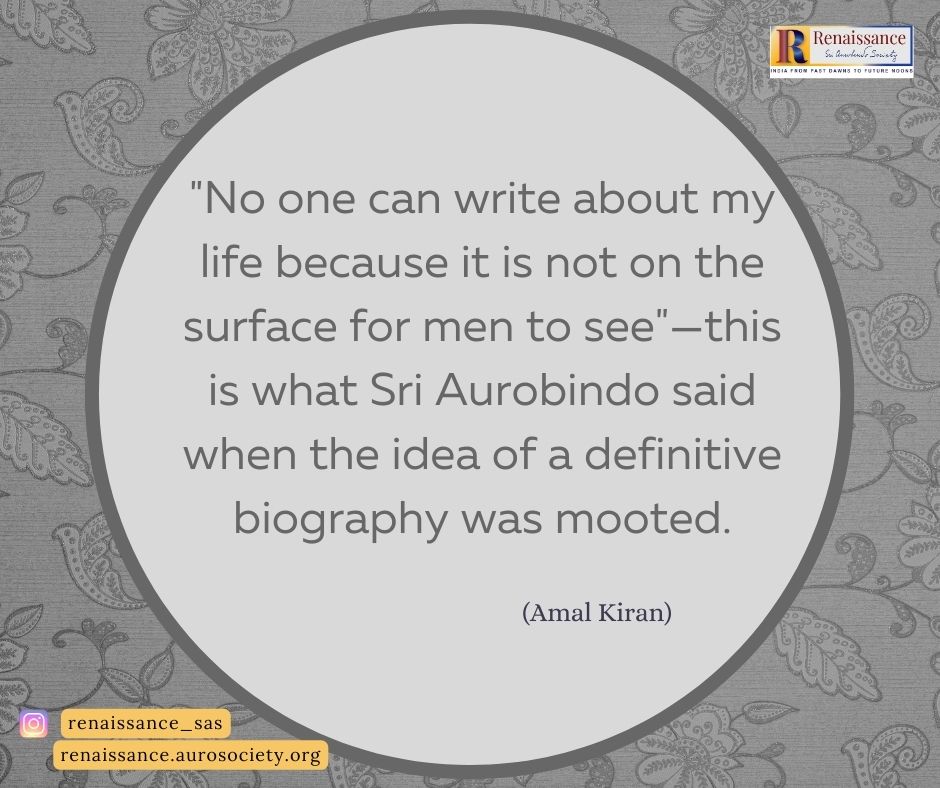
A Significance Integral
All the more inapplicable is the term “death” to the passing of a Master of Yoga like Sri Aurobindo. For, it is well known that the transformative power of the Supermind was at work in the very cells of his body and that it commanded an efficacy physical no less than psychological, to which hundreds of his disciples can testify because of the wonderful curative impact of it on their own ailments.
This efficacy was not confined to his Ashram: telegraphic offices all over India will bear witness to the daily flashing of appeals for help in various illnesses, including those that often defeat medical science, and then messages of thanksgiving for relief and remedy by spiritual means.
No, Sri Aurobindo, the Yogi of the Supermind descending into the outer as well as the inner being and bringing a divine life on earth in addition to the infinite immortality of the Beyond, cannot be looked upon as passing away on account of old age and physical causes. Whatever the purely clinical picture, it must have behind it a significance integral with his highly significant and immeasurably more-than-physical life of spiritual attainment.
That there should be a clinical picture instead of a miraculous vanishing trick is exactly in keeping with Sri Aurobindo’s Yoga.
His Yoga was meant to be a process and a progression of the evolutionary method. It aimed not at a bewildering superimposition of divine qualities which still left the gram of human nature unchanged, but at a spiritually organic luminous growth, an assimilation by nature of supernature, a marvellous and yet no freakish transfiguration, an intense working out within a life-time of what is not foreign to the purpose of terrestrial evolution but its inmost meaning whose unfoldment is in the very logic of things, though that unfoldment may ordinarily take aeons.
No Utter Supernormality
The evolutionary was always fused with the revolutionary in Sri Aurobindo’s Yoga of the Supermind.
Just as his life’s audacities, like those of his art of poetry and prose, were always felicitous, full of ease and aptness, gloriously adapting nature rather than violating it, so too the adventure of his death would be no utter supernormality but carry for all its profound import and exceptional mode some semblance of the common passage to the stillness and the shadow.
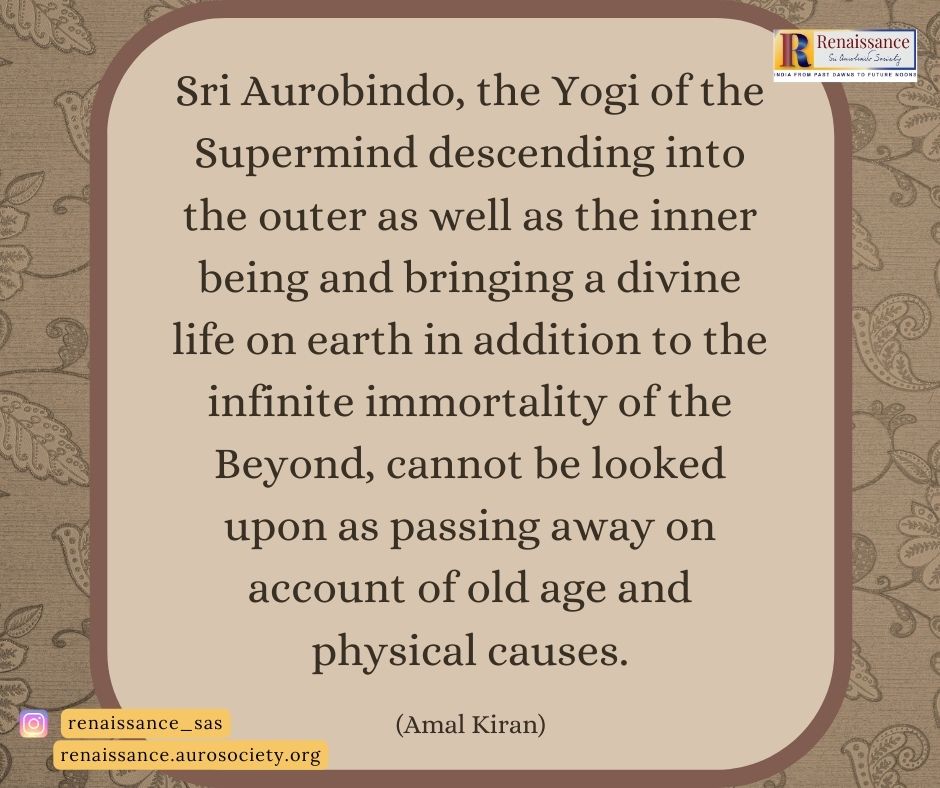
What medical science would try to describe as physical causes are, therefore, far indeed from being any contradiction of the thesis that Sri Aurobindo did not pass away as a result of them. And this thesis, we may now add, is based not only on Sri Aurobindo’s special spiritual status but also on a number of remarkable physical facts.
Doctors have declared, on the strength of typical non-response to stimuli, that he entered into deep coma in consequence of an extreme uraemic condition following upon a failure of all treatment. As every medical tyro knows, such a state of uraemic coma admits of no return to consciousness. Yet to the surprise of the doctors attending on him, Sri Aurobindo opened his eyes at frequent intervals and asked for a drink or inquired what the time was!
This repeated occurrence of the scientifically impossible leads one to believe that the deep uraemic coma was intermixed, as it were, with a very conscious Yogic self-withdrawal from an instrument which was too damaged to be kept for common use but which yet could not quite bar the uncommon will of its master.
Here was no brain of mere carbon and iron and phosphorus. Here was the subtilised servitor of a mind that had sat on the peaks of God and from there could command response in the midst of all material determinism. Even half an hour before the breathing ceased and the heart stopped beating, Sri Aurobindo looked out from his calm compassionate eyes, spoke the name of the doctor by his side and drank some water. This was the strangest uraemic coma in medical history.
Nor did the extraordinary character of the passing of this Yogi of Yogis end there. In a case certified to be one of complete pervasion of the system by the accumulation in the blood of body poisons which should be thrown off by the kidneys, the system gets discoloured in a short time, a blackening grows apace and then decomposition sets in.
Concentration of Supramental Light
But when there was a consultation of doctors, both, French and Indian, two and a half days after the death-certificate had been signed, Sri Aurobindo’s body was found to have retained the beautiful white-gold colour that had distinguished it during his life and there was not the slightest trace of decomposition.
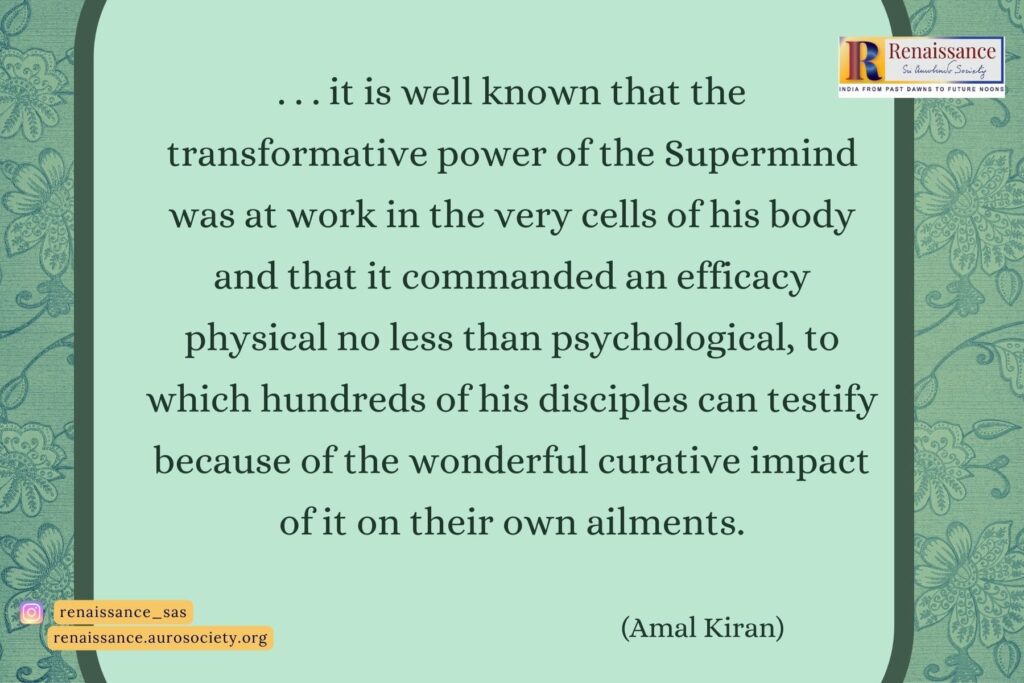
It was just as it had been at the moment of his passing—1.26 a.m. on December 5—and also just as it had been 41 hours later when instead of the scheduled burial the famous announcement was made by the Mother, indefinitely postponing it:
The funeral of Sri Aurobindo has not taken place today. His body is charged with such a concentration of supramental light that there is no sign of decomposition and the body will be kept lying on his bed so long as it remains intact.
~ K. R. Srinivasa Iyengar, Sri Aurobindo: A Biography and a History (2009), pp. 736-737
It lay intact for several days in a grandeur of victorious quiet, with thousands upon thousands having darshan of it.
Only at 5 p.m. on December 9, in a rosewood case lined with silver and satin, it was buried most simply and without any sectarian religious ceremony in a vault specially prepared in the centre of the Ashram courtyard. Even when the body was put into the case, there was neither actual decay nor the odour of death, though marks were present to indicate that the miraculous preservative light had begun to depart. The light may be said to have remained in full for over 90 hours—a period more than double the record time which Lyons’ Medical Jurisprudence gives of a body keeping undecayed in the climatic conditions of the East.

Continued in Part 2
~ Graphic design: Beloo Mehra & Biswajita Mohapatra

